Regular Steel Structure Inspections
Types of Structural Inspections
Regular inspections are essential to maintain the integrity of steel structures. There are several types of inspections, each serving a unique purpose in ensuring safety and durability.
- Visual Inspections: These are cursory checks that identify obvious issues such as rust, deformation, or visible damage. They are crucial for early detection of problems that a more detailed inspection might later uncover.
- Detailed Inspections: These involve a comprehensive assessment and may require specialized tools or equipment. Detailed inspections help in identifying potential risks that could lead to structural failure if not addressed timely.
- Special Inspections: These are tailored inspections addressing specific concerns, such as post-disaster evaluations or targeted assessments in areas prone to recurrent damage.
Scheduled inspections facilitate compliance with regulatory standards and help prevent unforeseen complications. By detecting issues early through regular inspections, costly repairs can be avoided, ensuring the longevity of steel structures.
Key Corrosion Checkpoints
Corrosion is a common issue for steel structures, particularly in areas exposed to moisture or chemicals. Identifying key corrosion checkpoints through regular inspections is crucial for proactive maintenance.
- Joints and Seams: These areas often accumulate water, leading to accelerated corrosion. Routine checks can help identify early signs of rust and prevent further spread.
- Areas in Contact with Water: Any section of the structure that regularly encounters water must be monitored closely. Corrosion rates can vary significantly; for instance, data shows that steel structures can experience an average corrosion rate increase of up to 20% annually in humid environments.
Utilizing modern techniques like ultrasonic testing and visual examination heightens the ability to detect corrosion, thereby enhancing the safety measures of steel structure maintenance.
Identifying Joint Fatigue Signs
Joint fatigue in steel structures manifests in various recognizable forms. Recognizing these signs early is vital for maintaining structural integrity.
- Visible Cracks and Displacement: These physical changes indicate stress or damage within the structure. Regular monitoring helps in documenting any changes over time that can guide future repairs.
- Unusual Noises During Operation: These noises can signify underlying issues that need immediate attention. Itâs crucial to stay alert to any changes that might indicate joint fatigue.
Experts highlight that environmental factors such as temperature fluctuations and exposure to elements can significantly impact joint fatigue. Therefore, timely inspections are recommended to minimize potential risks associated with joint fatigue, ensuring the structure remains safe and sound over time.
Anti-Corrosion Protection Methods
Galvanization vs Rust Inhibitor Coatings
For protecting steel from corrosion, most people look at either galvanizing or applying rust inhibitors. Galvanization works by putting a thick layer of zinc over the steel surface, which acts as a strong shield against rust and lasts many years. Rust inhibitors work differently they're basically chemicals painted or sprayed onto metal to stop oxidation from happening. These approaches vary quite a bit in how they're applied and how long they last. When dealing with really harsh conditions, galvanized steel stands up better over time, particularly where there's lots of moisture or salt air like near factories or coastal areas. The upside of rust inhibitors is that if they start wearing off, just slap on another coat rather than redoing the whole process. They tend to be cheaper upfront too, so contractors working within tight budgets often go this route. Looking at costs over time tells another story though. Sure, galvanization costs more initially, but those extra dollars usually pay themselves back through reduced maintenance expenses down the road. That makes galvanization a smarter choice for big infrastructure projects where nobody wants to worry about touch-ups every few years.
Humidity Monitoring Systems
Keeping tabs on humidity is really important when it comes to stopping corrosion before it starts, especially around steel structures where moisture control matters most. These monitoring systems basically watch what's happening with the air's dampness level and then kick in whatever controls are needed to bring things back into balance, which helps stop those pesky rust spots from forming. Companies that install such systems tend to see real benefits, particularly in places where humidity runs high all year round. Take warehouses or factories for example - just keeping moisture at reasonable levels there makes a huge difference in how often corrosion problems pop up. Research shows time and again that when humidity stays too high, steel structures start showing signs of wear much faster than they should. So instead of waiting for damage to happen, smart businesses get ahead of the problem by actively managing moisture conditions. This approach not only saves money in repairs down the road but keeps buildings and equipment performing well for years longer than they would otherwise.
Repairing Paint Damage Promptly
Getting to those paint chips and scratches quickly makes all the difference when it comes to stopping corrosion on steel structures. Without that protective coating intact, the metal underneath starts getting eaten away by rust pretty fast. Let me share what works best from experience: Check over surfaces regularly so problems don't go unnoticed. When something looks off, scrub away whatever grime or dirt has built up there first. Then slap on some good quality rust inhibitor primer before finishing with a matching top coat that actually sticks properly. Most maintenance folks know this isn't just about keeping things looking sharp either. The right paint job acts like armor against weather beating down on structures day after day. Fix those little cracks while they're still manageable instead of waiting until we've got big expensive repairs ahead because someone ignored the early warning signs.
Structural Integrity Maintenance
Bolt Tension Testing
Testing bolt tension matters a lot when it comes to keeping structures intact and avoiding parts falling apart. When bolts are tightened correctly, they hold connections together in steel frameworks. If not tight enough, joints might slip around and eventually cause whole structures to fail. There are several ways to check this stuff out in practice. Mechanics often grab torque wrenches or specialized tension meters to get readings and make needed tweaks on site. Some research points fingers at around 30 percent of all steel building collapses being linked back to bolts that weren't tightened properly. So regular checks with good equipment really count for something when wanting reliable and safe steel constructions across different projects.
Foundation Settlement Monitoring
Keeping an eye on how much a building's foundation settles into the ground matters a lot when it comes to steel structures staying healthy over time. When we start seeing things like cracks appearing in walls or floors that slope instead of being flat, those are red flags pointing towards bigger problems down the road. There are several ways professionals check this stuff out - some old school leveling tools still work great alongside modern settlement gauges that actually record data points as months pass by. Most engineers will tell anyone who listens about catching issues early on before they get expensive. Think about reinforcing footings properly or maybe even injecting stabilizing materials into unstable soils around the base. These aren't just theoretical fixes either; many construction sites have saved themselves from major headaches simply by tracking small movements in their foundations regularly. The bottom line remains pretty straightforward though: regular checks mean safer buildings standing tall for decades rather than collapsing unexpectedly.
Wind Load Reinforcement
Getting a good grasp of how wind affects buildings makes all the difference when it comes to strengthening steel structures, particularly where storms hit hard. Strong winds put serious stress on buildings and can lead to bending, twisting, or even collapse without proper support systems in place. Engineers typically rely on things like diagonal bracing and extra support members to hold up against these powerful forces. Following established building codes and best practices for wind resistance helps ensure structures stand firm during extreme weather events. When builders incorporate these reinforcement techniques, they're not just protecting the physical structure itself but making sure occupants stay safe and the building lasts much longer through years of exposure to harsh weather conditions.
Mechanical Component Lubrication
Roller Door Maintenance
Keeping roller doors well maintained makes all the difference when it comes to how they perform over time. The main things to focus on are lubricating moving parts, checking alignment, and looking at components closely during routine checks. When properly lubricated, there's less friction in operation. Good alignment means the door moves smoothly without getting stuck. Regular visual inspections help spot problems before they become major headaches. Most experts recommend setting up a maintenance plan with monthly lubrication sessions and full checkups once a year. Looking at warranty information from manufacturers shows something interesting too: those who stick to regular maintenance schedules tend to see fewer breakdowns and get much longer life out of their investment in roller doors.
Hinge Lubrication Schedules
Regular maintenance with proper lubrication makes all the difference when it comes to keeping hinges working smoothly without excessive wear. When hinges start making those annoying noises or feel stiff to move, that's basically nature's way of saying they need some love. Anyone who has dealt with squeaky doors knows exactly what I mean. Pay close attention to any strange creaking or grinding sounds coming from hinges during normal operation these are clear warning signs that lubrication should happen soon. For best results, grab a good quality lubricant that won't corrode whatever material the hinge is made from. Different materials require different treatments after all. Using the right product not only keeps things running better day to day but also extends how long those hinges will last before needing replacement.
Preventing Metal-on-Metal Wear
When metal parts rub against each other without enough lubrication, this creates what engineers call metal-on-metal wear. It happens when two surfaces come into direct contact, causing friction that wears them down over time until they eventually fail. According to various mechanical engineering reports, keeping things properly lubricated cuts down on this kind of damage quite a bit. Machines run better for longer periods when we take care of their lubrication needs regularly. For anyone wanting to keep their machinery running smoothly, developing good maintenance habits makes sense. Different machines need different kinds of lubricants applied in specific ways, so understanding what works best for particular equipment is pretty important in preventing those costly breakdowns later on.
Professional Assessment Protocols
Certified Inspector Criteria
Knowing what qualifies someone as a good inspector matters a lot when it comes to getting trustworthy structural evaluations done right. Inspectors who are properly certified typically bring several important things to the table including proper credentials, hands on experience over years, plus deep understanding of how buildings work. When these elements come together during an inspection, problems get caught before they become disasters, which means fewer surprises down the road. Contractors and building owners see real value in hiring certified folks because the whole assessment process becomes much more dependable, and safety standards stay where they need to be. Research across multiple industries consistently points toward better safety results when certified experts handle inspections. These pros know exactly where to look for weak spots in steel structures, often catching issues long before anyone else would notice them. Industry reports back this up too, showing clear improvements in safety metrics after implementing regular certified inspections, something every property manager knows is just common sense in today's world.

Non-Destructive Testing Methods
When it comes to checking steel structures, non-destructive testing methods like ultrasonic and radiographic testing play a really important role. These techniques let engineers look inside metal components without actually damaging them. What makes these tests so valuable is their ability to reveal what's going on beneath the surface of materials, giving technicians detailed insights about potential issues before they become serious problems. The advantages are pretty clear cut too. Precise assessments help keep safety standards up to par while also extending how long these structures last before needing replacement. Real world applications back this up across various industries. For example, many bridges and industrial facilities rely heavily on regular NDT checks to spot tiny cracks or weaknesses that would be impossible to see with the naked eye. By incorporating these testing approaches into routine maintenance schedules, companies save money in the long run by avoiding expensive emergency repairs and ensuring their infrastructure stays safe and functional for years to come.
Maintenance Record Documentation
Keeping good records of inspections and maintenance work is really important for both day-to-day structural upkeep and long term planning. When companies have detailed notes on what was done, when, and by whom, they stay compliant with all those pesky legal requirements while making better decisions about fixing problems or upgrading systems. Most professionals agree that having some sort of organized system for tracking maintenance makes life easier down the road. With everything documented properly, anyone can see exactly what repairs were made previously and make adjustments accurately if something goes wrong later. These records become gold mines of information when trying to keep steel structures within industry standards. They show patterns over time too, helping managers spot recurring issues before they turn into bigger headaches. Companies that get serious about their documentation tend to run smoother operations overall because everyone knows what's been done and what still needs attention.
FAQ
Why are regular inspections important for steel structures?
Regular inspections are crucial as they help maintain the structural integrity, ensure safety, and prevent costly repairs by identifying issues early.
What are some common methods of corrosion protection for steel structures?
Common methods include galvanization and rust inhibitor coatings, both of which protect steel structures from oxidization and rust.
How does bolt tension testing contribute to structural integrity?
Bolt tension testing ensures that connections are stable, helping prevent joint slippage and potential structural failures.
What role do certified inspectors play in structural maintenance?
Certified inspectors provide reliable assessments of steel structures, identifying vulnerabilities and ensuring compliance with safety standards.






